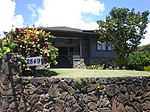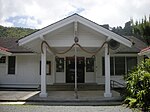Kamehameha Schools, formerly called Kamehameha Schools Bishop Estate (KSBE), is a private school system in Hawaiʻi established by the Bernice Pauahi Bishop Estate, under the terms of the will of Princess Bernice Pauahi Bishop, who was a formal member of the House of Kamehameha. Bishop's will established a trust called the "Bernice Pauahi Bishop Estate" that is Hawaiʻi's largest private landowner. Originally established in 1887 as an all-boys school for native Hawaiian children, it shared its grounds with the Bishop Museum. After it moved to another location, the museum took over two school halls. Kamehameha Schools opened its girls' school in 1894. It became coeducational in 1965. The 600-acre (2.4 km2) Kapālama campus opened in 1931, while the Maui and Hawaiʻi campuses opened in 1996 and 2001, respectively.It was developed at the bequest of Princess Bernice Pauahi Bishop to educate children of Hawaiian descent, and is designed to serve students from preschool through twelfth grade. The school teaches in the English language a college-prep education enhanced by Hawaiian culture, language and practices, imparting historical and practical value of continuing Hawaiian traditions. It operates 31 preschools statewide and three grade K–12 campuses in Kapālama, Oʻahu, Pukalani, Maui, and Keaʻau, Hawaiʻi.
By the terms of its founding, the schools' admissions policy prefers applicants with Native Hawaiian ancestry. Since 1965 it has excluded all but two non-Hawaiians from being admitted. A lawsuit challenging the school's admission policy resulted in a narrow victory for Kamehameha in the Ninth Circuit Court; however, Kamehameha ultimately settled, paying the plaintiff $7 million.As of the 2011–12 school year, Kamehameha had an enrollment of 5,398 students at its three main campuses and 1,317 children at its preschools, for a total enrollment of 5,416. Beyond its campuses, Kamehameha served an estimated 46,923 Hawaiians in 2011 through its support for public schools, charter schools, and families and caregivers throughout Hawaii.According to the Kamehameha Schools home website, the mission statement is as follows: "Kamehameha Schools' mission is to fulfill Pauahi's desire to create educational opportunities in perpetuity to improve the capability and well-being of people of Hawaiian ancestry."








